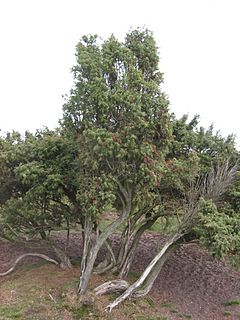Common Juniper facts for kids
Quick facts for kids Juniperus communis |
|
|---|---|
 |
|
| Juniperus communis subsp. communis in the Netherlands |
|
| Conservation status | |
| Scientific classification | |
| Kingdom: | |
| Division: | |
| Class: | |
| Order: | |
| Family: | |
| Genus: | |
| Species: |
J. communis
|
| Binomial name | |
| Juniperus communis |
|
Juniperus communis, also known as the Common Juniper, is a type of plant in the Juniper family. It grows in more places than almost any other tree or shrub! You can find it all over the cool parts of the Northern Hemisphere, including North America, Europe, and Asia.
Contents
What Does It Look Like?

The Common Juniper is usually a shrub that spreads out low to the ground. Sometimes, it can grow into a small evergreen tree up to 10 meters (about 33 feet) tall.
Its cones look like berries. They start out green when they are young. Over about 18 months, they slowly change to a dark purple-black color and get a waxy blue coating.
How Do People Use It?
For Crafts
The wood from the Common Juniper is usually too small to be used for big building projects. However, in places like Scandinavia, people use juniper wood to make small containers. These containers are great for storing things like butter and cheese. In Estonia, juniper wood is loved for its nice smell and how long it lasts. You can often find decorative items, like eating tools, made from juniper wood in Estonian craft shops and homes.
For Cooking
The blue-black seeds of the Common Juniper are often called "juniper berries". They have a strong, slightly bitter taste, so you usually don't eat them raw. Instead, they are often dried and crushed to add flavor to foods like meats, sauces, and stuffings. These berries also give a special taste to some drinks, like gin and certain beers. In Slovakia, their national drink called Borovička gets its flavor from juniper berry extract.
In Traditional Medicine
For a long time, many cultures have used juniper berries as medicine. For example, some Native American tribes used juniper berries as a natural remedy for diabetes. They would sometimes mix the berries with Berberis root bark to make a special herbal tea.
Images for kids
-
Juniperus communis wood pieces, with a U.S. penny for size comparison. Notice the narrow growth rings.
See also
 In Spanish: Enebro común para niños
In Spanish: Enebro común para niños










